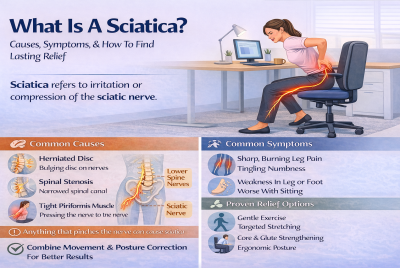Tips for Sciatica Pain Relief
Discover effective tips for sciatica pain relief with lifestyle changes, exercises, and treatments to ease discomfort and improve mobility. If you’re dealing with sciatica, I understand just how frustrating and painful it can be. Many people have asked me how they can manage sciatica at home and what practical steps they can take to relieve their pain. Today, I’m here to share some tips that I’ve seen work wonders for those struggling with sciatica pain.
Understanding Sciatica
What is Sciatica?
First, let’s get a grip on what sciatica actually is. Sciatica isn’t a condition in itself but rather a symptom of an underlying issue involving the sciatic nerve. This nerve is the longest in your body, running from your lower back through your hips and down each leg. When it’s pinched, inflamed, or irritated, you get that classic shooting pain down one leg, often with numbness or tingling.
Common Causes of Sciatica
A number of things can trigger sciatica. A herniated disc is one of the most common causes, but bone spurs, muscle inflammation, or even tight muscles in your hips can also put pressure on the sciatic nerve. Sometimes, the cause isn’t entirely clear, but addressing it can help alleviate your symptoms.
How Sciatica Pain Feels
Sciatica pain can be mild or excruciating and usually affects only one side of the body. It’s often described as a sharp, shooting pain that can make daily tasks feel impossible. Some people experience numbness or weakness, which can be even more distressing.
Lifestyle Changes to Alleviate Sciatica Pain
Why Physical Activity Matters
One of the biggest misconceptions about sciatica is that resting will help it go away. In reality, staying active can actually help. Regular movement prevents stiffness and helps reduce inflammation around the sciatic nerve.
Gentle Stretches to Try
Simple stretches like the knee-to-chest stretch or the seated spinal twist can work wonders. They help loosen tight muscles around your lower back and hips, which may be contributing to your pain.
Walking for Sciatica Relief
Walking is an excellent low-impact exercise that can ease sciatica pain. It increases blood flow to the affected area, helping reduce inflammation and encouraging healing.
The Importance of Good Posture
Bad posture is a hidden culprit in many cases of sciatica. Slouching or sitting for long periods can put added pressure on your lower back, aggravating your pain. If you have a desk job, make sure you’re using an ergonomic chair and maintaining proper posture.
Ergonomic Tips for Desk Jobs
If you sit all day for work, ensure your chair supports your lower back. Try to keep your feet flat on the ground and your computer screen at eye level to avoid hunching forward. Taking regular breaks to stretch can also help.
Weight Management for Pain Relief
Carrying extra weight, especially around the abdomen, can pull your spine out of alignment and put additional strain on the sciatic nerve. Incorporating a balanced diet and regular exercise not only helps you manage your weight but can also ease sciatica pain.
Pain Management Techniques
Over-the-Counter Medications
Nonsteroidal anti-inflammatory drugs (NSAIDs) like ibuprofen or aspirin can help reduce inflammation and relieve pain. However, it’s important not to rely on these long-term solutions and to consult a doctor if your pain persists.
Heat and Cold Therapy
Heat and cold packs are simple but effective tools for managing sciatica pain. Applying cold packs to the affected area can help reduce inflammation, while heat packs can relax tight muscles.
Topical Pain Relief
Creams and gels containing menthol or capsaicin can offer temporary relief when applied to the skin over the affected area. They work by numbing the nerves and providing a cooling or warming sensation.
Targeted Exercises for Sciatica Relief
Strengthening Your Core
A strong core supports your lower back and helps take pressure off the sciatic nerve. Exercises like planks or pelvic tilts can help strengthen these muscles, providing better support for your spine.
Stretching Your Hamstrings
Tight hamstrings can exacerbate sciatica by pulling on your lower back. Regularly stretching your hamstrings can help reduce tension and alleviate pain.
Yoga Poses for Sciatica
Certain yoga poses, like the pigeon pose or child’s pose, are particularly beneficial for relieving sciatica. These poses gently stretch and lengthen the muscles around your lower back and hips, easing pressure on the nerve.
The Role of Professional Help
When to See a Doctor
If your sciatica isn’t improving after a few weeks of self-care, or if it’s severely affecting your daily life, it might be time to see a doctor. They can help identify the underlying cause of your pain and suggest more targeted treatments.
Physical Therapy Benefits
A physical therapist can teach you exercises and stretches tailored to your specific condition. They can also help improve your posture and flexibility, which can provide long-term relief from sciatica.
Considering Chiropractic Care
Chiropractic adjustments can sometimes relieve pressure on the sciatic nerve. A chiropractor will focus on spinal alignment and may provide treatments like spinal manipulation or massage therapy to reduce your pain.
Mental Health and Sciatica
Managing Stress to Reduce Pain
Stress can make your perception of pain worse, which is why managing stress is so important. Practices like meditation, mindfulness, or even simple breathing exercises can help keep your stress in check, which in turn might help reduce your sciatica pain.
FAQs Related to Tips for Sciatica Pain Relief
Can sciatica go away on its own?
Yes, in many cases, sciatica can resolve on its own with rest, gentle exercise, and lifestyle changes. However, if the pain persists or worsens, it’s best to consult a doctor.
How long does sciatica last?
Sciatica can last anywhere from a few days to several months, depending on the severity and the underlying cause. With proper treatment, most people recover within 4 to 6 weeks.
Is walking good for sciatica?
Yes, walking is a low-impact exercise that promotes circulation and helps reduce inflammation, making it a great option for managing sciatica pain.
What should I avoid if I have sciatica?
Avoid activities that put extra pressure on your lower back, like heavy lifting, prolonged sitting, or high-impact exercises. These can aggravate the sciatic nerve and worsen your pain.
Can yoga really help with sciatica?
Absolutely. Yoga helps to stretch and strengthen muscles, improving flexibility and posture, which can relieve pressure on the sciatic nerve.
Are there any permanent treatments for sciatica?
For some people, lifestyle changes and exercise are enough to manage sciatica in the long term. In severe cases, surgery may be considered, but it’s often a last resort after trying other treatments.
Tips for Sciatica Pain Relief – Conclusion
Sciatica pain can be incredibly frustrating, but with the right approach, it’s manageable. By staying active, making some lifestyle adjustments, and seeking professional help when needed, you can significantly reduce your discomfort and improve your quality of life. Remember, you don’t have to suffer in silence—there are many ways to find relief.
Disclaimer
This article is for informational purposes only and is not a substitute for professional medical advice, diagnosis, or treatment. Always consult with your healthcare provider before starting a new exercise or stretching routine, especially if you have existing back or nerve conditions.
👉 Explore more:





